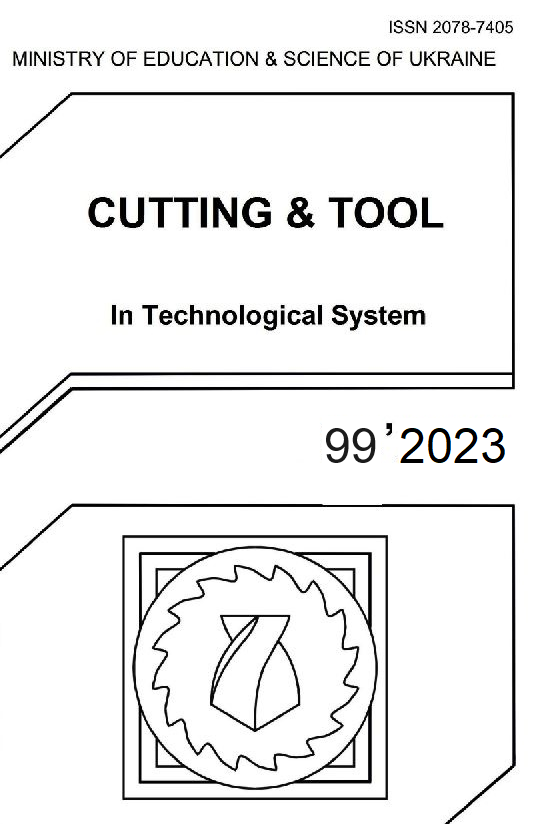INFLUENCE OF RADIAL DEPTH OF CUT ON INITIAL CONDITIONS OF OSCILLATIONS DURING END-MILLING OF THIN-WALLED PARTS
DOI:
https://doi.org/10.20998/2078-7405.2023.99.14Keywords:
milling, up and down-feed, radial depth of cut, accompanying free oscillations of the technological system, cutting time, thickness of the cut layerAbstract
Milling is widely used in mechanical engineering and other industries. Optimization of this process can lead to improved quality of machined parts, increased productivity and reduced wear of equipment. The paper investigates an important aspect of the milling process, namely the influence of radial depth of cut on the properties of the tool-part technological system (TS) and the amplitude of vibrations during machining. Vibrations can be a direct cause of reduction of quality and accuracy of machined parts. When the amplitude of vibrations increases, their impact on accuracy becomes critical. The analysis of studies of up and down end-milling with different radial depths of cut in the third speed zone of oscillations shows that with increasing radial depth of cut the cutting time and maximum thickness of the cut layer increases. This affects the length of the cutting surface and the character of the workpiece oscillations during up and down-milling. The length of the cutting surface determines how many waves of accompanying free oscillations of the TS and with what intensity will leave their trace on the cutting surface. In up-milling, the thickness of the cut layer increases with increasing radial depth of cut, while the amplitude of the accompanying free oscillations TS and their period decrease. At down milling the thickness of the cut layer decreases, and the amplitude of accompanying free oscillations of the TS and their period increase. A common characteristic feature of up and down-milling is the shaping of the machined surface in the cutting zone with a small thickness of the cut layer. In up-milling, this area is at the beginning of cutting, when the oscillation conditions are the same for all radial cutting depths. Therefore, the machined surfaces after up-milling with different radial cutting depths have close values of pitch and undulation height. At down-milling with increasing radial depth of cut, the amplitude of accompanying free oscillations of the TS in the profiling zone increases. This leads to an increase in the pitch and height of undulations on the machined surface. When milling in the third speed oscillation zone, it is necessary to select the radial depth of cut so that the cutting time is less than the period of the accompanying free oscillations of the TS. This will avoid undesirable oscillations and improve the quality of machining. The paper provides important results and recommendations for optimizing the milling process, considering the influence of radial depth of cut on TS properties and vibration amplitude. These findings may be useful for professionals working in the field of cutting materials processing to improve the efficiency and quality of production processes.
References
Munoa J, Beudaert X, Erkorkmaz K, et al. Active suppression of structural chatter vibrations using machine drives and accelerometers. CIRP Annals. 2015; 64(1):385–388.
Zhou X, Zhang DH, Luo M, et al. Toolpath dependent chatter suppression in multi-axis milling of hollow fan blades with ball-end cutter. The International Journal of Advanced Manufacturing Technology. 2014;72 (5-8):643–651.
Yilong L, Baohai W, Ming L, Dinghua Z Modeling and cutting path optimization of shallow shell considering its varying dynamics during machining. 15th CIRP Conference on Modelling of Machining Operations, 31. 2015;521 – 526.
Budak E. An analytical design method for milling cutters with nonconstant pitch to increase stability – Part I: Theory; Part II: Application, Trans. ASME Journal of Manufacturing Science and Engineering, 125;2003:29–38.
Stepan G., Hajdu D, Iglesias, A, Takacs D, Dombovari Z Ultimate Capability of Variable Pitch Milling Cutters. CIRP Ann., 2018;67(1): 373–376.
Zhan D, Jiang S, Niu J, Sun Y Dynamics Modeling and Stability Analysis of Five-Axis Ball-End Milling System with Variable Pitch Tools. Int. J. Mech. Sci., 2020;182:105774.
Stepan G, Hajdu D, Iglesias A, et al. Ultimate capability of variable pitch milling cutters. CIRP Annals. 2018;67(1):373-376.
Schmitz TL, Smith KS. Machining Dynamics. Springer US; 2009.
Dyadya S, Vnukov Y, Kozlova O, Trishyn P Regularities of Oscillations During Turning and End Milling. Advanced Manufacturing Processes V. Selected Papers from the 5th Grabchenko’s International Conference on Advanced Manufacturing Processes (InterPartner-2023), September 5–8, 2023, Odessa, Ukraine, 136-144.
Mazur MP, Vnukov YuM, Grabchenko AI, Dobroskok VL, Zaloga VO, Novosolov YuK, Yakubov FYa Osnovi teoriyi rizannya materialiv. Lviv:Novij Svit-2000, 2020:471 p. [in Ukrainian]
Vnukov Yu. N, Dyaya SI, Kozlova Ye. B, Logominov VA, Chernovol N.N. Self-oscillations when milling thin-walled elements of parts. Zaporizhzhia: ZNTU; 2017. 208 p.
Strelkov S.P. Vvedenie v teoriyu kolebanij. Moscow.: Izd-vo Nauka;1964: 438 p. [in Russian].
Downloads
Published
Issue
Section
License
Copyright Notice
Authors who publish with this Collection agree to the following terms:
1. Authors retain copyright and grant the Collection right of first publication with the work simultaneously licensed under a Creative Commons Attribution License that allows others to share the work with an acknowledgement of the work's authorship and initial publication in this Collection.
2. Authors are able to enter into separate, additional contractual arrangements for the non-exclusive distribution of the Collection's published version of the work (e.g., post it to an institutional repository or publish it in a book), with an acknowledgement of its initial publication in this Collection.
3. Authors are permitted and encouraged to post their work online (e.g., in institutional repositories or on their website) prior to and during the submission process, as it can lead to productive exchanges, as well as earlier and greater citation of published work.

